同位语考点难点
- 格式:docx
- 大小:17.78 KB
- 文档页数:2
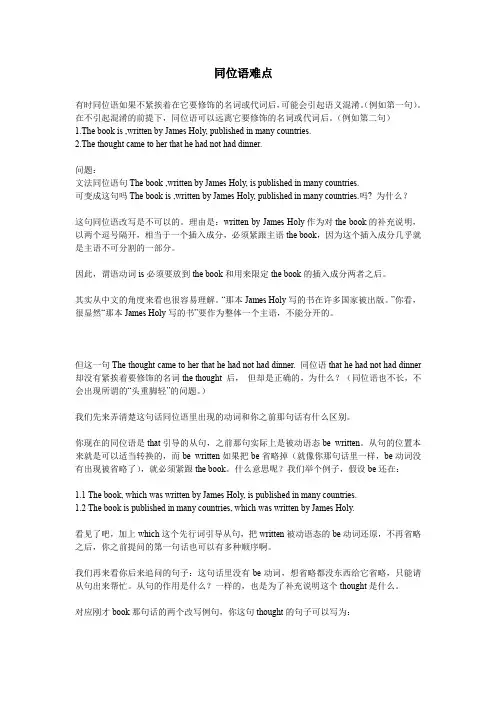
同位语难点有时同位语如果不紧挨着在它要修饰的名词或代词后,可能会引起语义混淆。
(例如第一句)。
在不引起混淆的前提下,同位语可以远离它要修饰的名词或代词后。
(例如第二句)1.The book is ,written by James Holy, published in many countries.2.The thought came to her that he had not had dinner.问题:文法同位语句The book ,written by James Holy, is published in many countries.可变成这句吗The book is ,written by James Holy, published in many countries.吗? 为什么?这句同位语改写是不可以的。
理由是:written by James Holy作为对the book的补充说明,以两个逗号隔开,相当于一个插入成分,必须紧跟主语the book,因为这个插入成分几乎就是主语不可分割的一部分。
因此,谓语动词is必须要放到the book和用来限定the book的插入成分两者之后。
其实从中文的角度来看也很容易理解。
“那本James Holy写的书在许多国家被出版。
”你看,很显然“那本James Holy写的书”要作为整体一个主语,不能分开的。
但这一句The thought came to her that he had not had dinner. 同位语that he had not had dinner 却没有紧挨着要修饰的名词the thought 后,但却是正确的,为什么?(同位语也不长,不会出现所谓的“头重脚轻”的问题。
)我们先来弄清楚这句话同位语里出现的动词和你之前那句话有什么区别。
你现在的同位语是that引导的从句,之前那句实际上是被动语态be written。
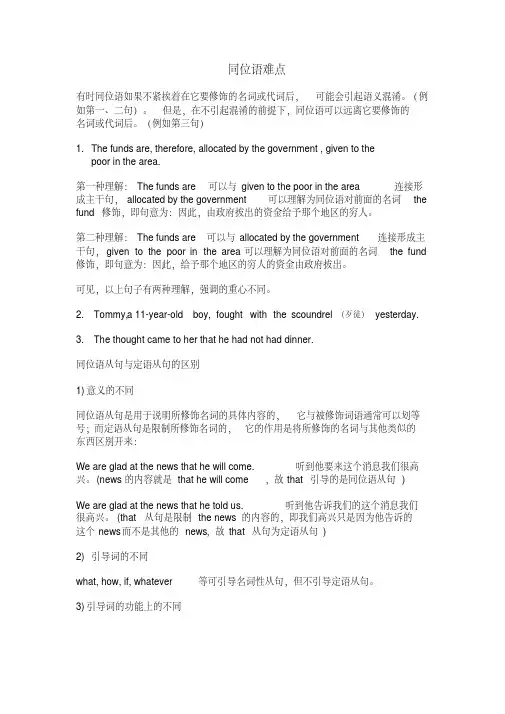
同位语难点有时同位语如果不紧挨着在它要修饰的名词或代词后,可能会引起语义混淆。
(例如第一、二句)。
但是,在不引起混淆的前提下,同位语可以远离它要修饰的名词或代词后。
(例如第三句)1.The funds are, therefore, allocated by the government , given to thepoor in the area.第一种理解:The funds are 可以与given to the poor in the area 连接形成主干句,allocated by the government 可以理解为同位语对前面的名词the fund 修饰,即句意为:因此,由政府拔出的资金给予那个地区的穷人。
第二种理解:The funds are 可以与allocated by the government连接形成主干句,given to the poor in the area可以理解为同位语对前面的名词the fund 修饰,即句意为:因此,给予那个地区的穷人的资金由政府拔出。
可见,以上句子有两种理解,强调的重心不同。
2. Tommy, a 11-year-old boy, fought with the scoundrel(歹徒) yesterday.3. The thought came to her that he had not had dinner.同位语从句与定语从句的区别1)意义的不同同位语从句是用于说明所修饰名词的具体内容的,它与被修饰词语通常可以划等号;而定语从句是限制所修饰名词的,它的作用是将所修饰的名词与其他类似的东西区别开来:We are glad at the news that he will come. 听到他要来这个消息我们很高兴。
(news的内容就是that he will come,故that引导的是同位语从句)We are glad at the news that he told us. 听到他告诉我们的这个消息我们很高兴。
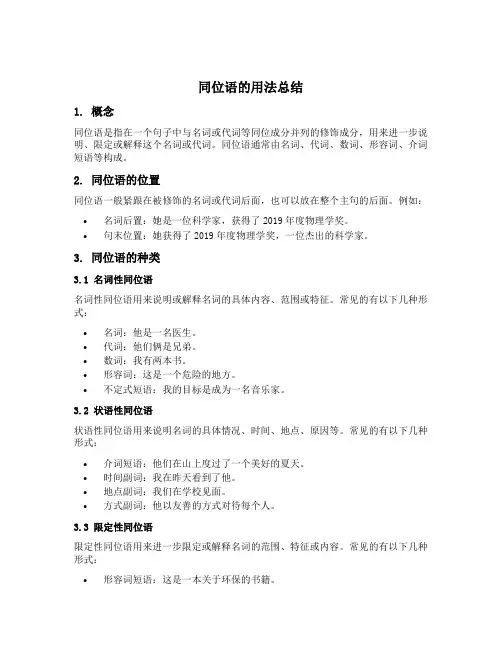
同位语的用法总结1. 概念同位语是指在一个句子中与名词或代词等同位成分并列的修饰成分,用来进一步说明、限定或解释这个名词或代词。
同位语通常由名词、代词、数词、形容词、介词短语等构成。
2. 同位语的位置同位语一般紧跟在被修饰的名词或代词后面,也可以放在整个主句的后面。
例如:•名词后置:她是一位科学家,获得了2019年度物理学奖。
•句末位置:她获得了2019年度物理学奖,一位杰出的科学家。
3. 同位语的种类3.1 名词性同位语名词性同位语用来说明或解释名词的具体内容、范围或特征。
常见的有以下几种形式:•名词:他是一名医生。
•代词:他们俩是兄弟。
•数词:我有两本书。
•形容词:这是一个危险的地方。
•不定式短语:我的目标是成为一名音乐家。
3.2 状语性同位语状语性同位语用来说明名词的具体情况、时间、地点、原因等。
常见的有以下几种形式:•介词短语:他们在山上度过了一个美好的夏天。
•时间副词:我在昨天看到了他。
•地点副词:我们在学校见面。
•方式副词:他以友善的方式对待每个人。
3.3 限定性同位语限定性同位语用来进一步限定或解释名词的范围、特征或内容。
常见的有以下几种形式:•形容词短语:这是一本关于环保的书籍。
•从句:我听说他去了巴黎。
•关系代词从句:这是我认识的那个人。
3.4 补充性同位语补充性同位语用来补充说明名词,增加额外信息,但并非必需。
常见的有以下几种形式:•名词短语:她是一位科学家,同时也是一位作家。
•不定式短语:我的目标是成为一名音乐家,同时也要努力学习其他学科。
4. 同位语与关系从句的区别同位语和关系从句都可以用来修饰名词,但它们有一些区别:•从句是一个完整的句子结构,而同位语只是一个短语或词组。
•从句通常由连词引导,而同位语没有连词。
•关系从句通常不能放在名词之后,而同位语可以。
例如:•关系从句:我听说他去了巴黎的消息。
•同位语:我听说他去了巴黎。
5. 同位语的重要作用同位语在句子中起到了以下几个重要的作用:5.1 确定名词的具体内容和范围同位语通过进一步说明、限定或解释名词,使读者或听者更加清楚地理解名词所指代的对象。
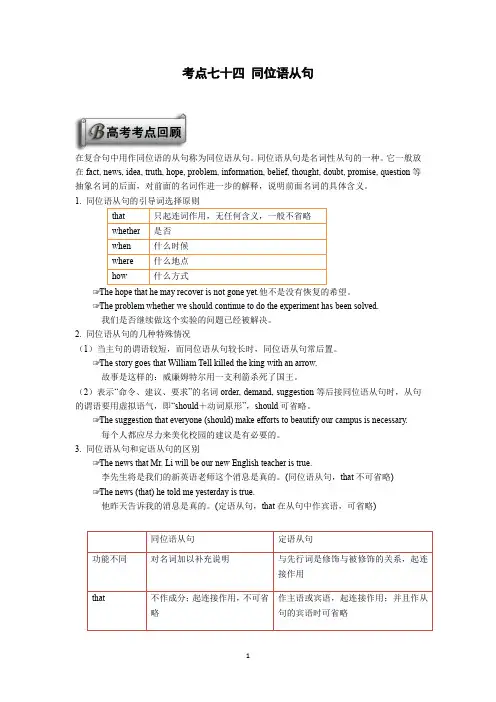
考点七十四同位语从句在复合句中用作同位语的从句称为同位语从句。
同位语从句是名词性从句的一种。
它一般放在fact, news, idea, truth, hope, problem, information, belief, thought, doubt, promise, question等抽象名词的后面,对前面的名词作进一步的解释,说明前面名词的具体含义。
1.☞The hope that he may recover is not gone yet.他不是没有恢复的希望。
☞The problem whether we should continue to do the experiment has been solved.我们是否继续做这个实验的问题已经被解决。
2. 同位语从句的几种特殊情况(1)当主句的谓语较短,而同位语从句较长时,同位语从句常后置。
☞The story goes that William Tell killed the king with an arrow.故事是这样的:威廉姆特尔用一支利箭杀死了国王。
(2)表示“命令、建议、要求”的名词order, demand, suggestion等后接同位语从句时,从句的谓语要用虚拟语气,即“should+动词原形”,should可省略。
☞The suggestion that everyone (should) make efforts to beautify our campus is necessary.每个人都应尽力来美化校园的建议是有必要的。
3. 同位语从句和定语从句的区别☞The news that Mr. Li will be our new English teacher is true.李先生将是我们的新英语老师这个消息是真的。
(同位语从句,that不可省略)☞The news (that) he told me yesterday is true.他昨天告诉我的消息是真的。
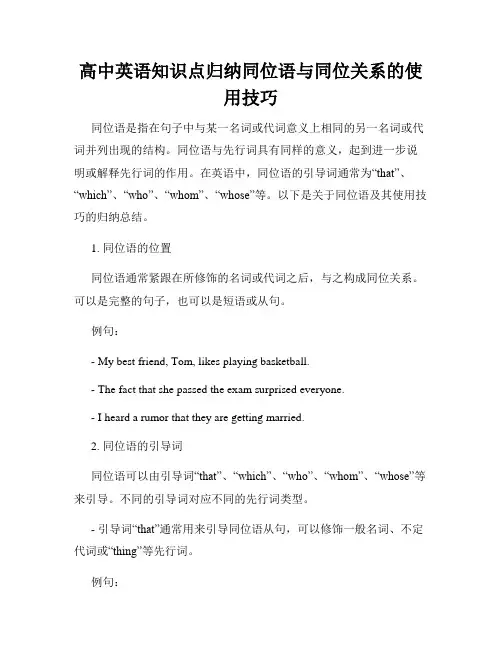
高中英语知识点归纳同位语与同位关系的使用技巧同位语是指在句子中与某一名词或代词意义上相同的另一名词或代词并列出现的结构。
同位语与先行词具有同样的意义,起到进一步说明或解释先行词的作用。
在英语中,同位语的引导词通常为“that”、“which”、“who”、“whom”、“whose”等。
以下是关于同位语及其使用技巧的归纳总结。
1. 同位语的位置同位语通常紧跟在所修饰的名词或代词之后,与之构成同位关系。
可以是完整的句子,也可以是短语或从句。
例句:- My best friend, Tom, likes playing basketball.- The fact that she passed the exam surprised everyone.- I heard a rumor that they are getting married.2. 同位语的引导词同位语可以由引导词“that”、“which”、“who”、“whom”、“whose”等来引导。
不同的引导词对应不同的先行词类型。
- 引导词“that”通常用来引导同位语从句,可以修饰一般名词、不定代词或“thing”等先行词。
例句:- The idea that you suggested is quite interesting.- Do you know the person that I met yesterday?- 引导词“which”通常用来引导同位语从句,修饰先行词为“thing”或具有事物特征的名词。
例句:- The book, which I read last week, was very informative.- The table at which we had dinner was beautifully decorated.- 引导词“who”、“whom”用来引导同位语从句,修饰先行词为人。
例句:- We all admire Anna, who won the first prize in the competition.- The person whom I saw in the park was my old friend.- 引导词“whose”用于引导同位语从句,修饰具有所有关系的名词。
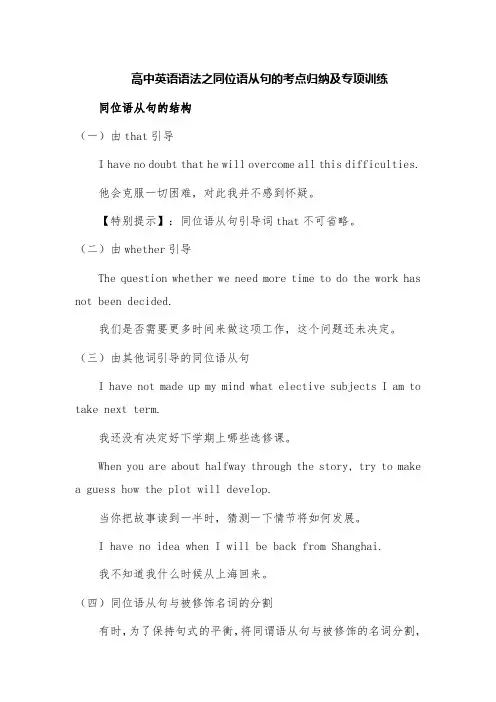
高中英语语法之同位语从句的考点归纳及专项训练同位语从句的结构(一)由that引导I have no doubt that he will overcome all this difficulties.他会克服一切困难,对此我并不感到怀疑。
【特别提示】:同位语从句引导词that不可省略。
(二)由whether引导The question whether we need more time to do the work has not been decided.我们是否需要更多时间来做这项工作,这个问题还未决定。
(三)由其他词引导的同位语从句I have not made up my mind what elective subjects I am to take next term.我还没有决定好下学期上哪些选修课。
When you are about halfway through the story, try to make a guess how the plot will develop.当你把故事读到一半时,猜测一下情节将如何发展。
I have no idea when I will be back from Shanghai.我不知道我什么时候从上海回来。
(四)同位语从句与被修饰名词的分割有时,为了保持句式的平衡,将同谓语从句与被修饰的名词分割,其间出现其他成分。
Concerns were raised that witnesses might be encouraged to exaggerate their stories in court to ensure guilty verdicts.人们日益担心,证人可能会因此而受到鼓励,在法庭上夸大事实(这里先行词concerns与that 以保证陪审团对被告做出有罪的判决。
同位语从句被谓语were raised隔开。
)同位语从句的引导词运用1.that引导同位语从句。
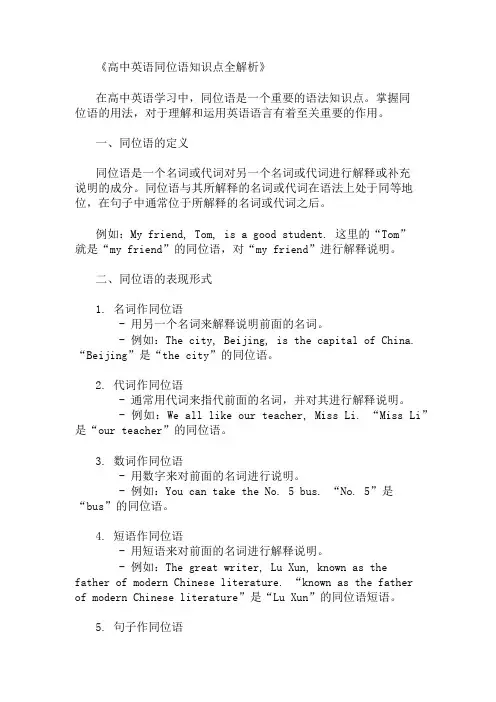
《高中英语同位语知识点全解析》在高中英语学习中,同位语是一个重要的语法知识点。
掌握同位语的用法,对于理解和运用英语语言有着至关重要的作用。
一、同位语的定义同位语是一个名词或代词对另一个名词或代词进行解释或补充说明的成分。
同位语与其所解释的名词或代词在语法上处于同等地位,在句子中通常位于所解释的名词或代词之后。
例如:My friend, Tom, is a good student. 这里的“Tom”就是“my friend”的同位语,对“my friend”进行解释说明。
二、同位语的表现形式1. 名词作同位语- 用另一个名词来解释说明前面的名词。
- 例如:The city, Beijing, is the capital of China. “Beijing”是“the city”的同位语。
2. 代词作同位语- 通常用代词来指代前面的名词,并对其进行解释说明。
- 例如:We all like our teacher, Miss Li. “Miss Li”是“our teacher”的同位语。
3. 数词作同位语- 用数字来对前面的名词进行说明。
- 例如:You can take the No. 5 bus. “No. 5”是“bus”的同位语。
4. 短语作同位语- 用短语来对前面的名词进行解释说明。
- 例如:The great writer, Lu Xun, known as thefather of modern Chinese literature. “known as the fatherof modern Chinese literature”是“Lu Xun”的同位语短语。
5. 句子作同位语- 用一个句子来对前面的名词进行解释说明,这个句子被称为同位语从句。
- 例如:The news that he won the first prize is exciting. “that he won the first prize”是“the news”的同位语从句。
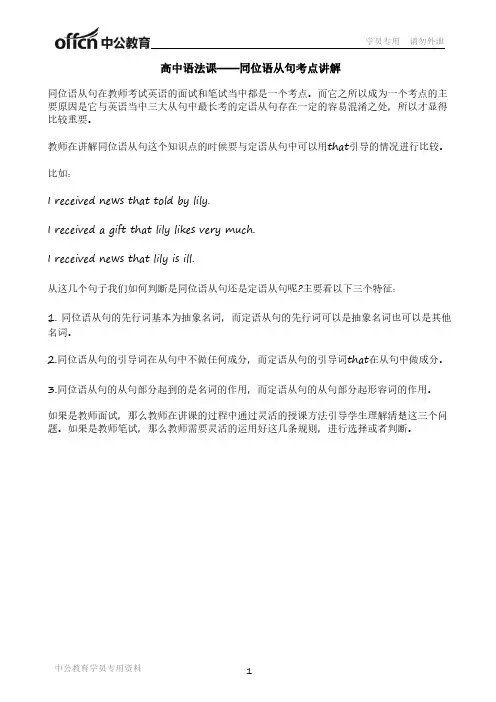
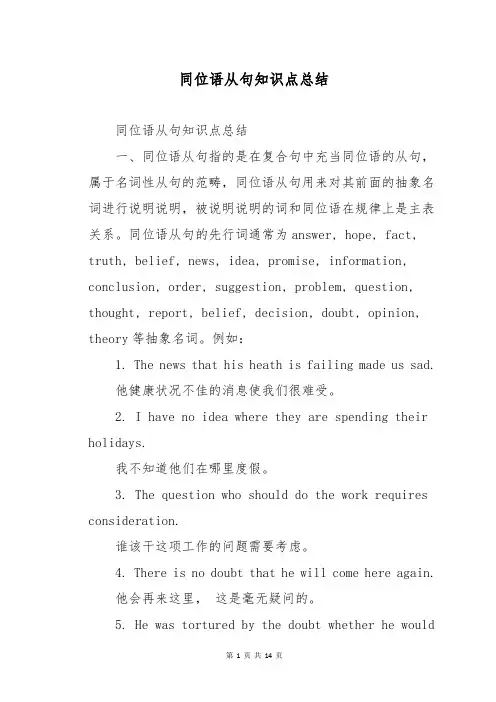
同位语从句知识点总结同位语从句知识点总结一、同位语从句指的是在复合句中充当同位语的从句,属于名词性从句的范畴,同位语从句用来对其前面的抽象名词进行说明说明,被说明说明的词和同位语在规律上是主表关系。
同位语从句的先行词通常为answer, hope, fact, truth, belief, news, idea, promise, information, conclusion, order, suggestion, problem, question, thought, report, belief, decision, doubt, opinion, theory等抽象名词。
例如:1. The news that his heath is failing made us sad.他健康状况不佳的消息使我们很难受。
2. I have no idea where they are spending their holidays.我不知道他们在哪里度假。
3. The question who should do the work requires consideration.谁该干这项工作的问题需要考虑。
4. There is no doubt that he will come here again.他会再来这里,这是毫无疑问的。
5. He was tortured by the doubt whether he wouldaccept their presents.他被是否接受他们的礼物这个疑虑所磨折着。
二、掌控同位语从句的用法要留意以下两个问题:1. 同位语从句有时可以不紧跟在它所说明的名词后面,而是被别的词隔开,以使得整个句子的结构显得平衡。
例如:He got the news from Mary that the sports meeting was put off. 他从玛丽那里获知了运动会被推迟的消息。
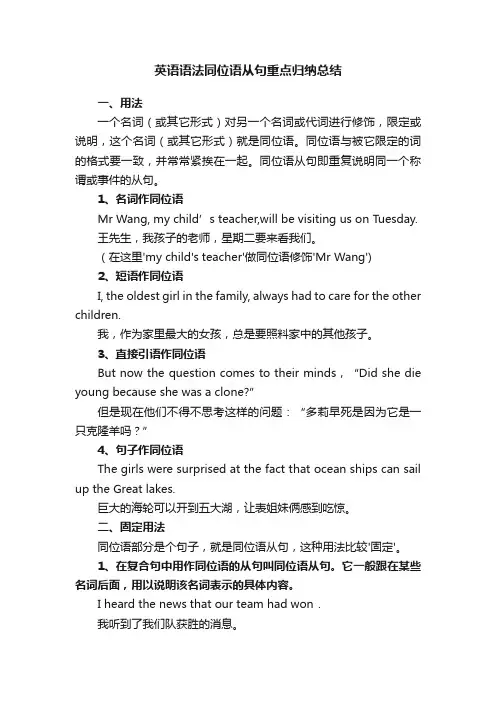
英语语法同位语从句重点归纳总结一、用法一个名词(或其它形式)对另一个名词或代词进行修饰,限定或说明,这个名词(或其它形式)就是同位语。
同位语与被它限定的词的格式要一致,并常常紧挨在一起。
同位语从句即重复说明同一个称谓或事件的从句。
1、名词作同位语Mr Wang, my child’s teacher,will be visiting us on Tuesday.王先生,我孩子的老师,星期二要来看我们。
(在这里'my child's teacher'做同位语修饰'Mr Wang')2、短语作同位语I, the oldest girl in the family, always had to care for the other children.我,作为家里最大的女孩,总是要照料家中的其他孩子。
3、直接引语作同位语But now the question comes to their minds,“Did she die young b ecause she was a clone?”但是现在他们不得不思考这样的问题:“多莉早死是因为它是一只克隆羊吗?”4、句子作同位语The girls were surprised at the fact that ocean ships can sail up the Great lakes.巨大的海轮可以开到五大湖,让表姐妹俩感到吃惊。
二、固定用法同位语部分是个句子,就是同位语从句,这种用法比较'固定'。
1、在复合句中用作同位语的从句叫同位语从句。
它一般跟在某些名词后面,用以说明该名词表示的具体内容。
I heard the news that our team had won.我听到了我们队获胜的消息。
2、可以跟同位语从句的名词通常有news,idea,fact,promise,question,doubt,thought,hope,message,suggestion,words(消息),possibility,decision等(一般的“抽象”名词都可用)。
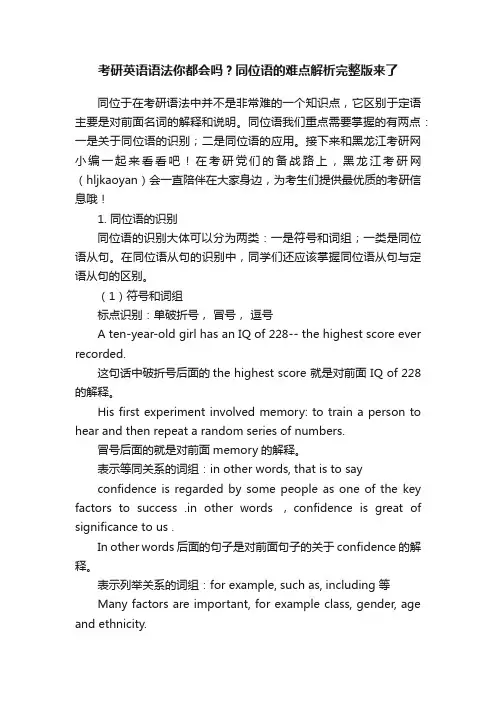
考研英语语法你都会吗?同位语的难点解析完整版来了同位于在考研语法中并不是非常难的一个知识点,它区别于定语主要是对前面名词的解释和说明。
同位语我们重点需要掌握的有两点:一是关于同位语的识别;二是同位语的应用。
接下来和黑龙江考研网小编一起来看看吧!在考研党们的备战路上,黑龙江考研网(hljkaoyan)会一直陪伴在大家身边,为考生们提供最优质的考研信息哦!1. 同位语的识别同位语的识别大体可以分为两类:一是符号和词组;一类是同位语从句。
在同位语从句的识别中,同学们还应该掌握同位语从句与定语从句的区别。
(1)符号和词组标点识别:单破折号,冒号,逗号A ten-year-old girl has an IQ of 228-- the highest score ever recorded.这句话中破折号后面的the highest score 就是对前面 IQ of 228 的解释。
His first experiment involved memory: to train a person to hear and then repeat a random series of numbers.冒号后面的就是对前面memory的解释。
表示等同关系的词组:in other words, that is to sayconfidence is regarded by some people as one of the key factors to success .in other words ,confidence is great of significance to us .In other words 后面的句子是对前面句子的关于confidence的解释。
表示列举关系的词组:for example, such as, including 等Many factors are important, for example class, gender, age and ethnicity.For example后面是对 many factors 的距离和说明表示突出关系的词组: especially, particularly等Millions of wild flowers colour the valleys, especially in April and May.(2)同位语从句同位语从句一般跟在抽象名词之后,并且通常用that引导,常见的抽象名词有:news, idea, fact, doubt, hope 等。
同位语从句重难点解析(含习题)一、同位语从句概述同位语从句是用以解释说明某一名词内容的从句,常见的可以被同位语从句修饰的名词有:belief,chance,doubt,hope,idea,news,opinion,thought,promise等。
引导同位语从句的词有连词that,whether和副词how,when,where等。
二、同位语从句点拨(1)同位语从句是意义完整的陈述句时,用连词that引导。
注:that在从句中不充当任何成分,只起连接作用,通常不省略。
如:I got the news that he would come to seeme the next week.(2)同位语从句是疑问句时,应根据语境选用who,when ,where,how,whether(不能用if)等词来引导。
如:The question who is the best for the job requires consideration.(3)分隔式同位语从句:当主句的谓语较短,而同位语从句较长时,为了使句子保持平衡,常把同位语从句后置。
如:An idea came to him that he could buy her a diamondring.(4)后面常跟同位语的词有:doubt,fact,hope,idea,message,news,possibility,promise,question,suggestion,truth,thought,warning,wish等。
注:advice,order,suggestion等词表示建议、命令的词后的同位语从句中的谓语动词须用(should) +动词原形。
如:He made the suggestion that themeeting(should) be put off.三、同位语从句与定语从句的区别(1)所表达的内容不同:同位语从句和定语从句一般是放在某一名词后面,但同位语从句是对该名词的解释和说明,而定语从句是对该名词的修饰,说明它的性质特征。
千里之行,始于足下。
202X届高考英语语法之同位语从句的考点归纳讲义同位语从句是高考英语语法中的一个重要考点,消灭频率较高。
同位语从句是名词性从句的一种,主要由that引导,可以用来修饰名词或代词,作同位语。
同位语从句主要有以下几种用法和结构:1. 说明或解释同位词的内容或概念例:The fact that he failed the exam surprised us.(同位语从句说明白same的内容)2. 表示同位关系:名词+“the fact/idea/belief”+that从句例:There is no doubt the project will be completed on time.(同位语从句表示同位关系)3. 表示同位地位:名词+that从句例:I have the feeling that we've met before.(同位语从句表示同位地位)4. 表示证明、证明的含义:名词+that从句例:The news that she passed the driving test pleased her parents.(同位语从句表示证明的含义)5. 用来引用或重述前文内容:名词+that从句例:She was disappointed at the fact that she didn't get the job.(同位语从句引用前文内容)第1页/共2页锲而不舍,金石可镂。
同位语从句的连接词主要有that,有时也可以用whether/if来引导。
当主句已经使用了某种连接词时,同位语从句就用that来引导,而不用whether/if。
此外,当同位语从句与前面的词有排比关系时,用连词or可将并列的成分连接在一起。
同位语从句的限制和留意事项:1. 当同位语从句是用来表示目的、结果、程度、缘由等的时候,可以使用so, such, too, enough等进行修饰。
同位语知识点总结同位语的种类同位语主要有名词性的同位语和非名词性的同位语两种。
名词性的同位语有名词、代词、数词、量词、名词短语和从句等,而非名词性的同位语有形容词、副词、动词短语等。
名词性的同位语:指作为同位语的成分是名词、代词等名词性成分的一种同位语。
如:老师,学校的领导;北京,中国的首都非名词性的同位语:指作为同位语的成分是形容词、副词等非名词性成分的一种同位语。
如:亲切,温暖的微笑;清新,宜人的空气同位语的特点同位语和它所说明的成分之间是一个对等的关系,表示相同的概念。
在句中起到修饰、解释、补充作用。
同位语一般和其说明的成分之间没有链接词或者连接关系词的引导,其同位关系通过语境或者句子结构来体现。
同位语之间的语义关系较为密切,通常在语境中略有变换,但仍不影响主体信息。
同位语位置一般在其说明的成分之后,但在书面语中也有时放在其说明的成分之前。
同位语在句子中的运用同位语可以对名词、代词、数词等进行解释、说明和补充。
在句子结构中,同位语一般放在被修饰的词或短语之后,常用逗号、破折号、顿号等进行标点。
同位语在句子中的作用通常为对所说明的名词、代词等进行解释、补充或说明。
1. 对同位语进行解释同位语可以对名词、代词进行解释,说明其具体的成员、范围、属性等。
如:这座城市,中国的首都,方便出行;她,我的好朋友,经常和我一起上学2. 对同位语进行补充同位语可以对名词、代词进行补充,增加其修饰的成分之间的相互补充、对应关系。
如:他,那个小伙子,是我儿子的朋友;读书,学习知识,是每个学生的任务3. 对同位语进行说明同位语可以对名词、代词进行说明,说明其具体的情况、属性、特征等。
如:这首歌,温馨、动听,深受大家喜爱;那个地方,景色秀丽,是一个旅游胜地同位语在句子中的典型表现同位语在句子中的表现形式比较灵活,可以通过名词、代词、数词、名词短语、从句等多种形式来体现。
其典型表现形式主要包括以下几种:1. 名词性同位语名词性同位语是指由名词、代词、数词、量词、名词短语、从句等名词性词组成的同位语。
高中英语同位语的知识点高中英语同位语的知识点同位语是英语语法中的一个重要概念,尤其是在高中英语中,同位语的使用频率非常高,因此理解同位语的语法规则和用法非常重要。
本文将详细介绍高中英语中同位语的知识点,包括同位语的定义、分类、位置、语法规则、注意事项等方面的内容。
一、同位语的定义同位语是指在一个句子中,与另一个词或短语同等重要的词或短语,用来解释、补充或说明它。
同位语通常用来修饰名词,也可修饰代词、数词、形容词、副词等,或直接与主语或谓语相连。
例如:1. We visited the famous Great Wall, the symbol of China’s long history.2. Shakespeare, the renowned dramatist, is widely regarded as the greatest writer in English literature.在上述两个句子中,Great Wall和symbol、Shakespeare和dramatist都是同位语。
同位语通常用逗号隔开,但在口语中或者在紧密联系的语境中,有时可以省略逗号。
二、同位语的分类同位语可以分为以下几类:限定性、非限定性、解释性和举例性。
(1)限定性同位语限定性同位语是对前面的名词起限定、修饰或具体化作用。
它与前面的名词是不可分割的整体,所以不用逗号隔开。
例如:1. My brother, a college student, is studying in Beijing.2. The book written by Hemingway is very interesting.(2)非限定性同位语非限定性同位语是对前面的名词进行补充说明或者加强作用。
它与前面的名词有一定的独立性,一般用逗号隔开。
例如:1. The teacher, Mrs. Smith, is very patient.2. The city, with its beautiful gardens and lakes, is a popular tourist destination.(3)解释性同位语解释性同位语是对前面名词的含义和用法进行解释和说明的,通常是用“即”、“就是”来引出的。
考研英语长难句语法考点之同位语从句长难句语法的考点之同位语从句可能对于有些语法基础比较薄弱的同学对这些考点的掌握程度并不高,借此机会我们可以来重温一下。
具体的考研英语长难句语法考点之定语从句内容介绍如下。
2019考研英语长难句语法考点之同位语从句1理论常识同位语从句是对其前面的抽象名词(例如:idea , insistence , instruction , order , plan , proposal 等)进行解释说明,被解释说明的词和同位语在逻辑上是主表关系。
同位语从句的结构一定是先行词加引导词加上从句的构成,that并不是唯一可以引导同位语从句的引导词,whether , why , who. 从句一定要具有完整的句子结构,主谓宾都必须齐全,引导词不充当任何成分。
常见先行词:belief , fact , hope , idea , doubt , news , rumor , conclusion , evidence ,suggestion , problem , order , answer , decision , discovery , explanation , information , knowledge , law ,opinion , truth , promise , report , thought , statement , rule , possibility .2真题举例例句1:Scientists jumped to the rescue with some distinctly shaky evidence to the effect that insects would eat us up if birds failed to control them . (2010,46)【重点词汇解析】distinctly,adv. 明显地;eat up 吃光、耗尽【参考翻译】科学家急忙用一些明显站不住脚的证据去营救,证据内容是如果鸟类不能控制昆虫的话,他们会把我们吃光。
英语同位语语法知识的归纳有关英语同位语语法知识的归纳在平日的学习中,是不是听到知识点,就立刻清醒了?知识点也可以通俗的理解为重要的内容。
那么,都有哪些知识点呢?下面是小编收集整理的有关英语同位语语法知识点的归纳,希望对大家有所帮助。
什么叫同位语当两个指同一人或事物的句子成分放在同等位置时,若其中一个句子成分是用于说明或解释另一个句子成分的,那么用于起说明或解释作用的句子成分就叫做另一成分的同位语。
如:Laura Myers,a BBC reporter,asked for an interview.劳拉迈尔,BBC的记者,要求采访。
Influenza,a common disease,has no cure.流行性感冒是一种常见病,无特效药。
Mary,one of the most intelligent girls I know,is planning to attend the university.玛丽是我所认识的最聪敏的姑娘之一,她正准备上大学。
Who is that man,the first in the front row?前排第一个人是谁?We have two children,a boy and a girl.我们有两个孩子,一个男孩和一个女孩。
以上所举的同位语例子都是同位语的基本形式,一般不会出错。
但有有几种同位语,或由于身本结构特殊,或由于它修饰的成分结构比较特殊,往往会引起误解。
现小结并举例说明如下,希望引起同学们的注意。
特殊同位语归纳代词we,us,you等后接同位语Are you two reading?你们二人在看书吗?They three joined the school team.他们3人参加了校队。
同位语从句同位语从句就是在复合句中作名词的同位语的名词性从句。
1.同位语从句的功能同位语从句对于名词进一步解释,说明名词的具体内容,一般由that引导,例如:1)The king’s decision that the prisoner would be set free surprised all the people.2)The order that all the soldiers should stay still is given by the general.2.同位语在句子中的位置同位语从句有时可以不紧跟在它所说明的名词后面,而是被别的词隔开。
同位语难点
有时同位语如果不紧挨着在它要修饰的名词或代词后,可能会引起语义混淆。
(例如第一、二句)。
但是,在不引起混淆的前提下,同位语可以远离它要修饰的名词或代词后。
(例如第三句)
1.The funds are, therefore, allocated by the government , given to the
poor in the area.
第一种理解:The funds are 可以与given to the poor in the area 连接形成主干句,allocated by the government 可以理解为同位语对前面的名词the fund 修饰,即句意为:因此,由政府拔出的资金给予那个地区的穷人。
第二种理解:The funds are 可以与allocated by the government连接形成主干句,given to the poor in the area可以理解为同位语对前面的名词the fund 修饰,即句意为:因此,给予那个地区的穷人的资金由政府拔出。
可见,以上句子有两种理解,强调的重心不同。
2. Tommy, a 11-year-old boy, fought with the scoundrel(歹徒) yesterday.
3. The thought came to her that he had not had dinner.
同位语从句与定语从句的区别
1)意义的不同
同位语从句是用于说明所修饰名词的具体内容的,它与被修饰词语通常可以划等号;而定语从句是限制所修饰名词的,它的作用是将所修饰的名词与其他类似的东西区别开来:
We are glad at the news that he will come. 听到他要来这个消息我们很高兴。
(news的内容就是that he will come,故that引导的是同位语从句)
We are glad at the news that he told us. 听到他告诉我们的这个消息我们很高兴。
(that从句是限制the news的内容的,即我们高兴只是因为他告诉的这个news而不是其他的news,故that从句为定语从句)
2) 引导词的不同
what, how, if, whatever 等可引导名词性从句,但不引导定语从句。
3)引导词的功能上的不同
that引导同位语从句时,它不充当句子成分,而引导定语从句时,它作为关系代词,要么充当定语从句的主语,要么充当定语从句的宾语。
如上例 that he told us中的that就充当told的宾语。
4)被修饰词语的区别
同位语从句所修饰的名词比较有限,通常有hope, wish, idea, news, fact, promise, opinion, suggestion, truth等,而定语从句所修饰的名词则非常广泛。
另外,when和where 引导定语从句时,通常只修饰表示时间和地点的名词,而它们引导同位语从句时却不一定;又如why引导定语从句,它通常只修饰名词the reason,而它引导同位语从句时则不一定:
I have no idea when they will come . 我不知道他们什么时候来。
(同位语从句)
I’ll never forget t he days when I lived there.. 我永远不会忘记我住在那儿的日子。
(定语从句)。